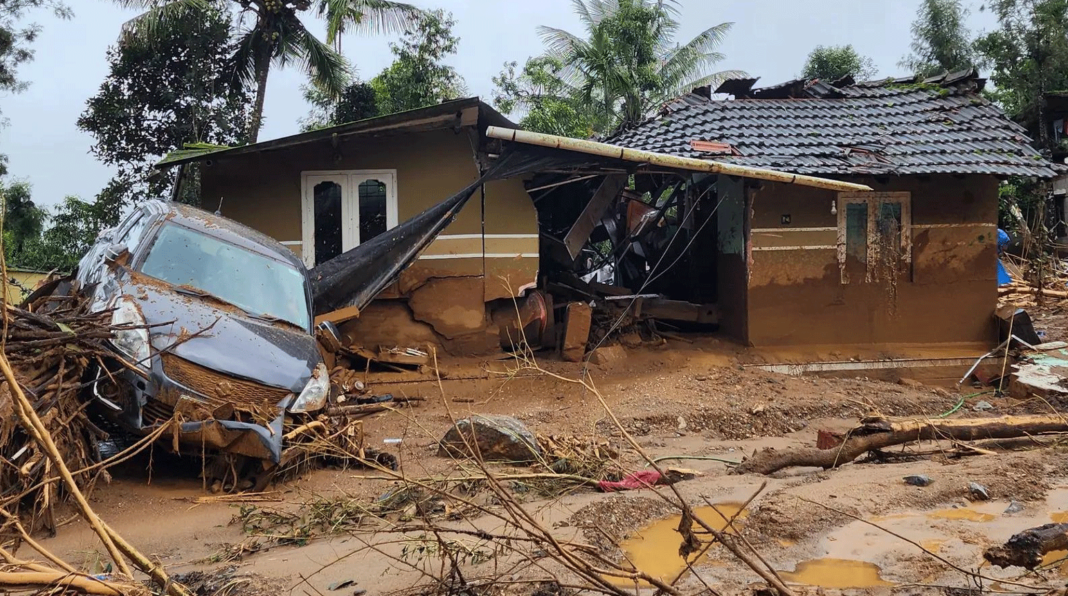Wayanad, July 30 (Agencies): More than 106 people were killed and 100 other individuals were reportedly missing in a devastating landslide in Kerala’s Wayanad region on Tuesday morning.
According to the report, major landslides rocked the mountainous terrain surrounding Meppadi in Kerala’s Wayanad district due to heavy downpours, resulting in at least 106 deaths, 128 injuries, and hundreds more suspected trapped.
250 members of the Fire and Rescue, Civil Defence, NDRF, and Local Emergency Response Teams are conducting rescue operation. An additional team of NDRF has been directed to reach the spot immediately, the official report said.
Chief Minister Pinarayi Vijayan assured all possible rescue operations to be coordinated in the landslides in Wayanad.
Prime Minister Narendra Modi expressed anguish over the loss of lives in landslides and assured Chief Minister Pinarayi Vijayan of all possible help from the Centre to deal with the crisis.
The Prime Minister announced a compensation of ₹ 2 lakh for the families of those who died. The injured would be given ₹ 50,000.
Scientists and experts called for a landslide prediction mechanism and construction of safe structures for the vulnerable population after the landslides.
Madhavan Rajeevan, former secretary of the Union Earth Sciences Ministry, said weather agencies can predict extremely heavy rainfall events, but whether that would trigger a landslide cannot be said with certainty.
Abhilash, the Director of the Advanced Centre for Atmospheric Radar Research at Cochin University of Science and Technology (CUSAT), reported that the states of Kasargod, Kannur, Wayanad, Calicut, and Malappuram have been experiencing substantial rainfall due to the active monsoon offshore trough impacting the entire Konkan region for the past two weeks.
“The soil was already saturated from continuous rainfall, and the formation of a deep mesoscale cloud system off the coast of the Arabian Sea on Monday triggered localised landslides in Wayanad, Calicut, Malappuram, and Kannur,” Abhilash stated in an interview with news agencies.
Abhilash drew parallels between the current cloud formations and those seen during the catastrophic floods in Kerala in 2019, emphasising that the recent weather patterns could signal a similar risk. Scientists have observed a trend in the development of very deep cloud systems over the southeast Arabian Sea, which occasionally intrude inland, similar to the events of 2019.
“The increasing warmth of the southeast Arabian Sea is destabilising the atmosphere above, contributing to the formation of these deep clouds. This atmospheric instability, linked to climate change, has shifted the rain-bearing belt southward, moving away from its historical zone in the northern Konkan region,” explained Abhilash.
As the intensity of rainfall increases, the likelihood of landslides in the high to mid-land slopes of the Western Ghats in eastern Kerala also rises during the monsoon season, according to the findings from their study.
In terms of immediate weather conditions, the IMD reported that several automatic weather stations across the districts of Thrissur, Palakkad, Kozhikode, Wayanad, Kannur, Malappuram, and Ernakulam recorded rainfall measurements ranging from 19 cm to 35 cm.
“Many IMD automatic weather stations in the affected areas documented rainfall exceeding 24 cm within 24 hours, with some farmer-installed stations recording over 30 cm,” Abhilash noted.
As the intensity of rainfall increases, the likelihood of landslides in the high to mid-land slopes of the Western Ghats in eastern Kerala also rises during the monsoon season, according to the findings from their study.
In terms of immediate weather conditions, the IMD reported that several automatic weather stations across the districts of Thrissur, Palakkad, Kozhikode, Wayanad, Kannur, Malappuram, and Ernakulam recorded rainfall measurements ranging from 19 cm to 35 cm. “Many IMD automatic weather stations in the affected areas documented rainfall exceeding 24 cm within 24 hours, with some farmer-installed stations recording over 30 cm,” Abhilash noted.




